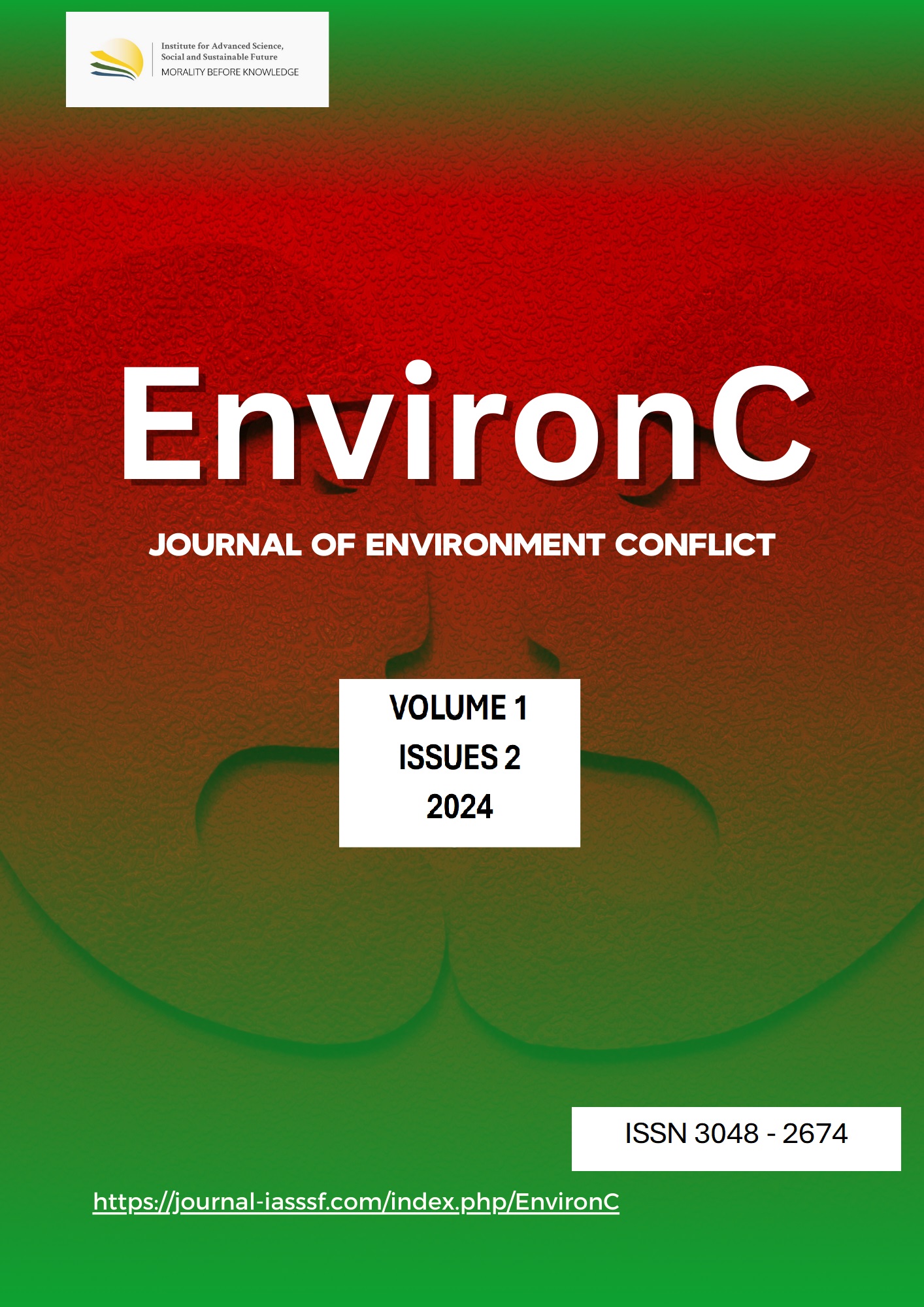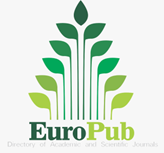Conflict analysis in chemical wastewater management: A case study on the recycling process in the heavy equipment industry in Jakarta
DOI:
https://doi.org/10.61511/environc.v1i2.2024.1474Keywords:
performance evaluation, water recycling, recycle units, clean water parametersAbstract
Background: One cause of water degradation is the large quantities of water consumption in industries, along with water pollution. Recycling wastewater offers a solution to this problem. As a wastewater-producing company, XYZ has implemented this solution. However, analysis of wastewater management revealed that some WWTPs did not meet the clean water requirements, necessitating additional processing units, specifically the addition of a recycling unit. Method: The recycling unit was added to reduce wastewater chemicals such as arsenic, iron, fluoride, cadmium, and others. A comparative analysis was conducted to assess the effectiveness of the recycling unit. Findings: The comparison indicated that the water parameters of the recycling unit’s effluent results were better than PDAM parameters, showing improvements in the water chemistry. Conclusion: The effectiveness of the recycling unit was validated, as it significantly lowered some chemical parameters in wastewater, producing effluent that was better than PDAM water and meeting the clean water quality standards outlined in Permenkes No. 416 of 1990 on Water Quality Monitoring. Novelty/Originality of this article: The novelty of this article lies in demonstrating the effectiveness of an added recycling unit in improving wastewater quality. It highlights a successful case of reducing harmful chemicals to surpass PDAM water quality, adhering to national standards.
References
American Public Health Association. (2005). Standard methods for the examination of water and wastewater 21st edition method 2540 D. Total suspended solids. In Standard Methods for the Examination of Water and Wastewater (pp. 2 - 58). APHA, AWWA, WEF Washington DC, USA.
Azapagic, A., Stamford, L., Youds, L., & Barteczko-Hibbert, C. (2016). Towards sustainable production and consumption: a novel decision-support framework integrating economic, environmental and social sustainability (DESIRES). Computers & Chemical Engineering, 91, 93-103. https://doi.org/10.1016/j.compchemeng.2016.03.017
Babbie, E. R. (2020). The practice of social research. Cengage Au.
Bae, T. H., & Tak, T. M. (2005). Effect of TiO2 nanoparticles on fouling mitigation of ultrafiltration membranes for activated sludge filtration. Journal of Membrane Science, 249(1-2), 1-8. https://doi.org/10.1016/j.memsci.2004.09.008
Borah, K. K., Bhuyan, B., & Sarma, H. P. (2010). Lead, arsenic, fluoride, and iron contamination of drinking water in the tea garden belt of Darrang district, Assam, India. Environmental monitoring and assessment, 169, 347-352. https://doi.org/10.1007/s10661-009-1176-2
Braman, R. S., & Foreback, C. C. (1973). Methylated forms of arsenic in the environment. Science, 182(4118), 1247-1249. https://doi.org/10.1126/science.182.4118.1247
Crecelius, E. A. (1974). The geochemistry of arsenic and antimony in Puget Sound and Lake Washington, Washington. University of Washington.
Gupta, S., & Babu, B. V. (2008). Removal of Toxic Metal Cr (VI) from Industrial Wastewater Using Sawdust as Adsorbent: Equilibrium, Kinetics and Regeneration Studies. J. Chem. Engg, 141, 1-20. https://doi.org/10.1016/j.cej.2009.01.013
Heidel, B., Rogge, T., & Scheffknecht, G. (2016). Controlled desorption of mercury in wet FGD waste water treatment. Applied Energy, 162, 1211-1217. https://doi.org/10.1016/j.apenergy.2015.05.016
Hess, T., Lennard, A., & Daccache, A. (2015) Comparing local and global water scarcity information in determining the water scarcity footprint of potato cultivation in Great Britain. Journal of Cleaner Production, 87, 666-674. https://doi.org/10.1016/j.jclepro.2014.10.075
Higgins, M. W., Rahmaan, A. S., Devarapalli, R. R., Shelke, M. V., & Jha, N. (2018). Carbon fabric based solar steam generation for waste water treatment. Solar Energy, 159, 800-810. https://doi.org/10.1016/j.solener.2017.11.055
Hu, P., Huang, J., Ouyang, Y., Wu, L., Song, J., Wang, S., ... & Christie, P. (2013). Water management affects arsenic and cadmium accumulation in different rice cultivars. Environmental geochemistry and health, 35, 767-778. https://doi.org/10.1007/s10653-013-9533-z
Hu, P., Ouyang, Y., Wu, L., Shen, L., Luo, Y., & Christie, P. (2015). Effects of water management on arsenic and cadmium speciation and accumulation in an upland rice cultivar. Journal of Environmental Sciences, 27, 225-231. https://doi.org/10.1016/j.jes.2014.05.048
Jeuland, M. (2015). Challenges to wastewater reuse in the Middle East and North Africa. Middle East Development Journal, 7(1), 1-25. https://doi.org/10.1080/17938120.2015.1019293
Jones, D. L., Freeman, C., & Sánchez-Rodríguez, A. R. (2017). Waste water treatment. In Encyclopedia of Applied Plant Sciences (pp. 352-362). Elsevier Ltd. https://doi.org/10.1016/B978-0-12-394807-6.00019-8
Kamizoulis, G., Bahri, A., Brissaud, F., & Angelakis, A. N. (2003). Wastewater recycling and reuse practices in Mediterranean region: Recommended Guidelines. Arab Water World Mag, 34. http://www.publicscienceframework.org/journal/paperInfo/jepsd?paperId=828
Koymatcik, C., Ozkaymak, M., & Selimli, S. (2018). Recovery of iron particles from waste water treatment plant of an iron and steel factory. Engineering Science and Technology, an International Journal, 21(3), 284-288. https://doi.org/10.1016/j.jestch.2018.04.008
Martín, M. A., Gutiérrez, M. C., Dios, M., Siles, J. A., & Chica, A. F. (2018). Application of ATAD technology for digesting sewage sludge in small towns: Operation and costs. Journal of environmental management, 215, 185-194. https://doi.org/10.1016/j.jenvman.2018.03.062
Maximous, N., Nakhla, G., Wong, K., & Wan, W. (2010). Optimization of Al2O3/PES membranes for wastewater filtration. Separation and Purification Technology, 73(2), 294-301. https://doi.org/10.1016/j.seppur.2010.04.016
Metcalf & Eddy. (2003). Wastewater Engineering: Treatment and Reuse. 4th Edition, McGraw-Hill.
Muijs, D. (2010). Doing quantitative research in education with SPSS. Sage.
Papa, M., Alfonsín, C., Moreira, M. T., & Bertanza, G. (2016). Ranking wastewater treatment trains based on their impacts and benefits on human health: A “Biological Assay and Disease” approach. Journal of cleaner production, 113, 311-317. https://doi.org/10.1016/j.jclepro.2015.11.021
Piadeh, F., Moghaddam, M. R. A., & Mardan, S. (2014). Present situation of wastewater treatment in the Iranian industrial estates: Recycle and reuse as a solution for achieving goals of eco-industrial parks. Resources, Conservation and Recycling, 92, 172-178. https://doi.org/10.1016/j.resconrec.2014.06.004
Prieto, M. A., Prieto, I., Vázquez, J. A., & Ferreira, I. C. (2015). An environmental management industrial solution for the treatment and reuse of mussel wastewaters. Science of the Total Environment, 538, 117-128. https://doi.org/10.1016/j.scitotenv.2015.07.041
Qu, X., Alvarez, P. J., & Li, Q. (2013). Applications of nanotechnology in water and wastewater treatment. Water research, 47(12), 3931-3946. https://doi.org/10.1016/j.watres.2012.09.058
Raghuvanshi, S., Bhakar, V., Sowmya, C., & Sangwan, K. S. (2017). Waste water treatment plant life cycle assessment: treatment process to reuse of water. Procedia CIRP, 61, 761-766. https://doi.org/10.1016/j.procir.2016.11.170
Razak, Z. K. A., Basri, M., Dzulkefly, K., Razak, C. N. A., & Salleh, A. B. (2001). Extraction and characterization of fish oil from Monopterus Albus. Malaysian Journal of Analytical Sciences, 7(1), 217-220.
Siswoyo, E., Mihara, Y., & Tanaka, S. (2014). Determination of key components and adsorption capacity of a low cost adsorbent based on sludge of drinking water treatment plant to adsorb cadmium ion in water. Applied Clay Science, 97, 146-152. https://doi.org/10.1016/j.clay.2014.05.024
Song, P., Huang, G., An, C., Shen, J., Zhang, P., Chen, X., ... & Sun, C. (2018). Treatment of rural domestic wastewater using multi-soil-layering systems: Performance evaluation, factorial analysis and numerical modeling. Science of the total environment, 644, 536-546. https://doi.org/10.1016/j.scitotenv.2018.06.331
Vasudevan, S., Jayaraj, J., Lakshmi, J., & Sozhan, G. (2009). Removal of iron from drinking water by electrocoagulation: adsorption and kinetics studies. Korean Journal of Chemical Engineering, 26, 1058-1064. https://doi.org/10.1007/s11814-009-0176-9
Veiga, L. B. E., & Magrini, A. (2009). Eco-industrial park development in Rio de Janeiro, Brazil: a tool for sustainable development. Journal of cleaner production, 17(7), 653-661. https://doi.org/10.1016/j.jclepro.2008.11.009
Verbruggen, A., Fischedick, M., Moomaw, W., Weir, T., Nadaï, A., Nilsson, L. J., ... & Sathaye, J. (2010). Renewable energy costs, potentials, barriers: Conceptual issues. Energy policy, 38(2), 850-861. https://doi.org/10.1016/j.enpol.2009.10.036
Vigneswaran, S. (Ed.). (2009). Wastewater Recycling, Reuse, and Reclamation-Vol. I. EOLSS Publishers/ UNESCO.
Wang, J., & Bai, Z. (2017). Fe-based catalysts for heterogeneous catalytic ozonation of emerging contaminants in water and wastewater. Chemical Engineering Journal, 312, 79-98. https://doi.org/10.1016/j.cej.2016.11.118
Weeraprapan, P., Phalaraksh, C., Chantara, S., & Kawashima, M. (2015). Water quality monitoring and cadmium contamination in the sediments of Mae Tao stream, Mae Sot District, Tak Province, Thailand. International Journal of Environmental Science and Development, 6(2), 142-146. http://dx.doi.org/10.7763/IJESD.2015.V6.577
Downloads
Published
How to Cite
Issue
Section
Citation Check
License
Copyright (c) 2025 Environment Conflict

This work is licensed under a Creative Commons Attribution 4.0 International License.











